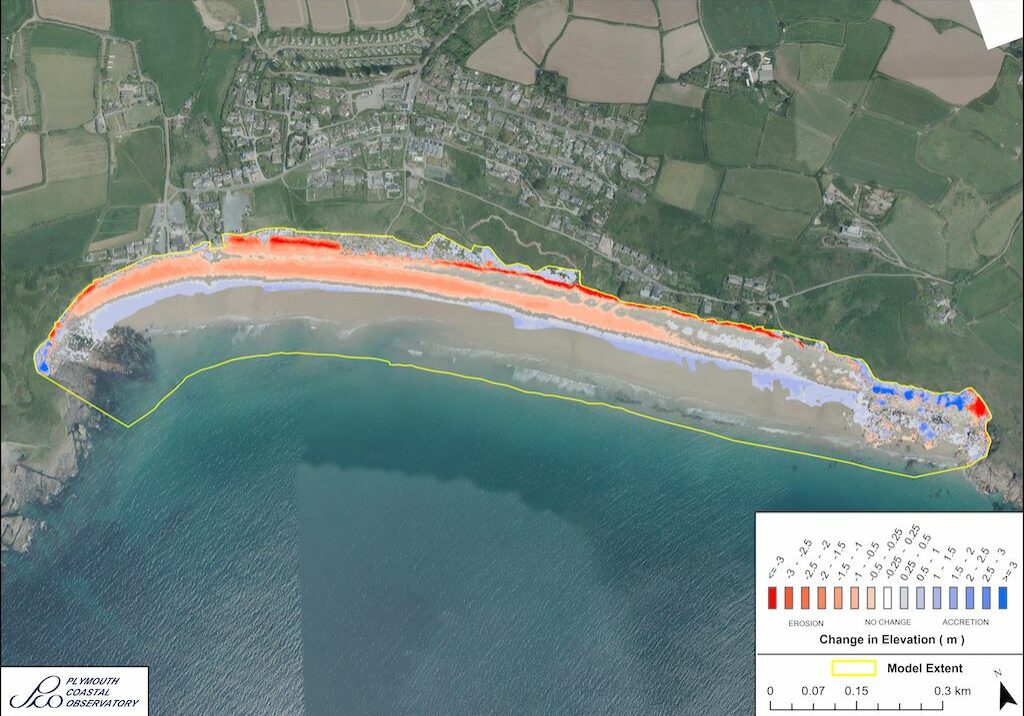
Praa Sands (Cornish: Poll-An-Wragh, meaning ‘Hag cove or pool’) is a wide south-west facing beach, on the south-west coast of Cornwall. A small stream flows onto the western side of the beach, the catchment of which only extends a short distance inland.
Praa Sands sits between the headlands of Rinsey Head to the south-east and Hoe Point to the north-west. The sediment on Praa Sands consists of soft, fine-grained sand, which at the centre of the beach forms a steep fronted dune system. The beach characteristics change on either flank of the beach, which is composed of low-lying steep cliffs of easily erodible periglacial head material. These eastern and western flanks of the beach are also areas where development is more focused.
Praa Sands is a location where there have been a number of historical finds. Peat layers underneath the sand tell a story of different sea-levels during the past ice-age, whilst nearby pre-historic and Bronze Age finds indicate the location was likely settled. The beach also has a surprising number of wreck sites associated with it, driven ashore by the unforgiving ocean.


Coastal Change
The coastline of Cornwall is an ever-changing environment. It is energetic, dynamic, never still and changes with each wave and each tidal cycle. Some of the changes we see are gradual and barely noticeable, whilst others, such as rockfalls, happen suddenly and often shockingly.
From one visit to the next it can sometimes be difficult to see how a beach and dune system has changed, but information has been collected, and is being collected through the Making Space for Sand project, to help us better understand how the coastline is changing. The purpose of this section of the website is to understand each location has changed over time, how it could change in the future and understand the policies that influence how we can respond to these changes.
Shoreline Management Plans (SMP)
The Shoreline Management Plan (SMP) is a strategic planning and management assessment tool that helps identify and measure the risk associated coastal erosion and coastal flooding. The document makes a number of policy recommendations over short, medium and long term timeframes setting out a strategic approach to managing the built, natural and historic environments associated with the coastline. Within SMP there are four policy approaches which have been assigned to stretches of coastlines. The four policies are: No Active Intervention (NAI), Hold the Line (HTL), Managed realignment (MR), and Advance the line (ATL).
Praa Sands sits within Policy Development Zone 7 (PDZ7), in Management Area 18 (MA18), within Policy Units (PU) 18.2 and 18.3. The policy recommendations for these policy units are detailed in the table below and the SMP can be accessed through the Cornwall Council website.
Use your touchscreen
to scroll the below table
| Policy Unit | SMP2 Policy Plan | ||||
| 2025 | 2055 | 2105 | Comment | ||
| 18.2 | Praa Sands east
Main Policy Sub Policy
|
MR SE |
MR SE |
NAI SE |
Maintain control over erosion rates to a sustainable level, without creating an unsustainable frontage. This needs to be linked in with the approach for Sydney Cove and the whole frontage can be managed under the same management scheme/approach. Maintain engagement with property owners on medium to long term risk of loss to erosion, including potential impacts on utilities.
|
| 18.3 | Praa Sands west (Sydney Cove)
Main Policy Sub Policy
|
MR P |
MR P |
MR P |
Managed realignment approach is preferred which links in with the Praa Sands East frontage. It is anticipated that residual life of defences would provide defence to the assets during epoch 1 if required as part of the overall MR approach. This should provide a sustainable approach to managing the risk to property and assets in the area.
|
| Key Main Policy: HTL - Hold the Line, A - Advance the Line, NAI – No Active Intervention MR – Managed Realignment
Sub Policy: P – Placeholder, CtM – Cease to Maintain |
|||||


National Coastal Erosion Risk Mapping (NCERM)
The basic NCERM lines show erosion estimates for the Short Term (ST-20 years), Medium Term (MT-50 years) and Long Term (LT- 100 years). The data is further categorised by probability: 05 is 5% probability (a 1 in 20 chance of being exceeded) Red Shading, 50 is 50% probability of being exceeded (a 1 in 2 chance of being either exceeded or not exceeded) Orange Shading and 95 is 95% probability (a 19 in 20 chance of being exceeded) Yellow Shading. Click the link below to access the Cornwall Council NCERM Mapping site read the about section then click on layers.

Historical Images of Praa Sands
Historical photographs provide a powerful insight into how the Cornish coastline has changed within the past Century. The Making Space for Sand project are working in collaboration with the Francis Frith collection and have been given permission to share historical images on a number of beaches considered within the project.
In looking back, we can better understand how the coastline has changed, helping us understand not only how the coastal fringe has developed but also the potential future changes that we my observe. When this is considered alongside forecasts of coastal erosion and sea level rise it will help enable us to better adapt to our changing coastline.
Praa Sands from Hoe Point Cliffs in 1927 (Image courtesy of the Francis Frith collection) and in 2024.
Praa Sands from Hoe Point Cliffs in 1935 (Image courtesy of the Francis Frith collection) and in 2024.

Modelling Coastal Change

Using data that has already been collected, combined with data collected through the Making Space for Sand project, a series of models will be carried out at each location. This will help us better understand how each location may respond to sea level rise and gain a deeper understanding of how coastal sediments move and behave.
The complexity of the modelling, and the data collection that helps inform it, means that modelling outputs will not be the same on all sites. Some locations will be more thoroughly investigated to understand more complex issues and provide data that can be more widely applied to other sites with similar characteristics.
As the project develops this section of the website will expand, sharing new reports and coastal change projections when they are produced.
LiDAR surveys, which are explained on the Data Modelling page, have been carried out by the South West Coastal Monitoring program at this location. The image shared here visualises where sand has eroded (areas shaded in red) and where it has built up (areas shaded in blue), between the LiDAR surveys carried out in 1998 and 2019. The darker the shade of red or blue the greater the amount of sand erosion or accumulation has been observed. The image helps visualise that beaches are areas that change shape over time and will continue to do so as sea levels rise.



Beach and Dune Ecology
Beaches and dunes represent an important transition between the marine environment and the terrestrial environment. This transition creates a range of special habitats and exposes a range of interesting features, which that can result in these spaces being highly designated and protected. The Making Space for Sand project will survey a number of dune systems. These surveys will help highlight how they may be changing, will identify rare species, will map invasive species, help us understand overall dune condition and identify potential constraints to improving their condition.
There are a range of designations that recognise a variety of different features. There are also a number of dunes systems where data has been collected to understand their habitat value. These are explored, on a site-by-site basis, in the section below.

Designations
Area of Outstanding Natural Beauty (AONB)
Areas of Outstanding Natural Beauty (AONB’s) are protected landscapes whose distinctive character and natural beauty are so outstanding that its in the nation’s interest to safeguard them. As such they have been nationally designated by the same legislation as National Parks and have the same status and level of protection.
Image of birds resting on buoys in the Helford River (Courtesy of Susan Scott)
Designated Cornwall National Landscape Area
From November 2023, all areas previously know as Areas of Outstanding Natural Beauty, or AONBs, were re-named National Landscape and in Cornwall became Cornwall National Landscape. However, the Management Plan still references the term AONB as this was formally adopted by Cornwall Council and cannot be amended until the next plan is produced.
The South Coast Western section covers an area of 19,258 hectares, which is 20% of the total Cornwall National Landscape. The key characteristics of this coastal landscape is a soft profile. It benefits from the protection offered by the Penwith peninsula against the full force of the Atlantic storms.
Image of boats at Cadgwith Harbour (Courtesy of Sue Rowlands)

Beach Dune Management Plan
Many of the sand dunes and beaches around Cornwall’s coast are experiencing erosion and sediment loss. This is due, in part, to lack of new sediment input to the shoreline system and rising sea levels. This is a pressing concern as these environments provide protection against the risk of coastal flooding, provide important habitats that cannot be easily recreated elsewhere if lost and help support the regions thriving tourism industry. It is therefore vital that the sand dunes and beaches around Cornwall’s coast are managed in a more sustainable way that balances the combined functions of beach-dune system.
In 2016, Cornwall Council produced Beach Dune Management Plans (BDMP’s) for 10 locations in Cornwall, including one at this location. The aim of the BDMP’s was to:
- Identify the best day-to-day management approach in terms of monitoring and intervention for the beach and dune system.
- Provide a longer-term approach to beach and dune management based upon an up-to-date understanding of coastal processes at the site, as well as predictions of future coastal evolution.
Where possible, the Making Space for Sand project will use these BDMP’s, supported by the data it collects, to work with landowners and environmental groups to help build more resilient and more biodiverse beaches and dunes that will help protect people and place from coastal erosion.
Sign up to Making Space for Sand
If you would like to get involved in helping to make dunes more resilient and biodiverse, want to help develop coastal adaptation and emergency plans or just want to know more about what the project is learning about coastal change, please click here:







